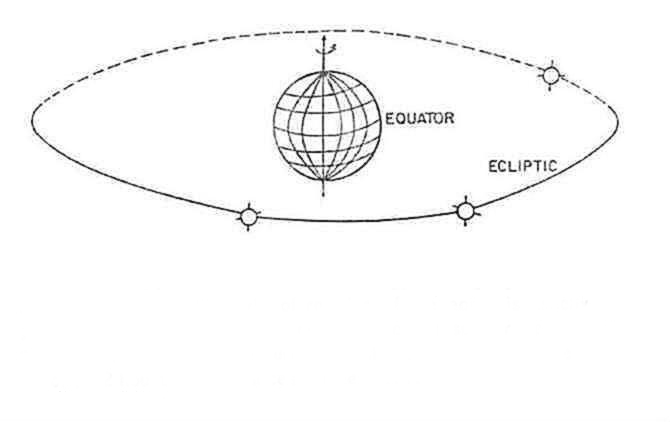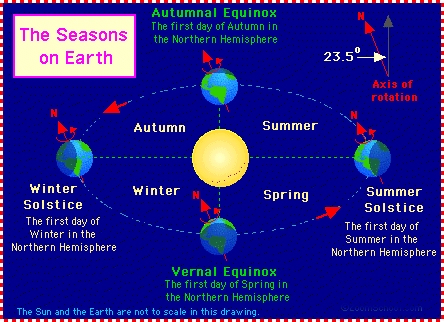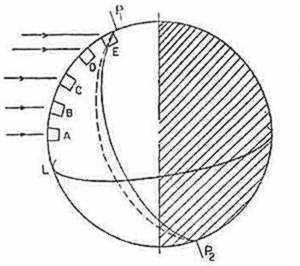Illustrations
To further your understanding about the seasons and their causes just go through these slides.
Slide 1 - Hypothetical Case where there is no Obliquity

Suppose the axis of rotation of the earth is exactly perpendicular to the plane of revolution of the sun or the plane of the ecliptic. Then, for any meridian (longitude), the duration of the day and the night will be exactly 12 hours each always and there would be no difference between one day and the other in the year. This is because, due to the earth 's rotation, the sun will be in front of any particular point on the earth for exactly 12 hours during which time it will be above the horizon for that point. During the next 12 hours, that particular point would not be facing the sun and it will be night time there.
In the above case, as there is no difference between one day and the other, there will also be no change of seasons throughout the year.
Slide 2 - What actually happens - Obliquity and Seasons

When the sun is at S2, the Northern Hemisphere is tilted towards the sun's rays whereas the Southern Hemisphere is tilted away from the sun in this position. So, the Northern Hemisphere receives more light and energy than usual from the sun in this position, and it is summer time there. The Southern Hemisphere receives less light and energy than usual from the sun in this position and it is wintertime there. The situation gets reversed when the sun is in position S4. In this position, the Southern Hemisphere is tilted towards the sun and it is summer there whereas the Northern Hemisphere is tilted away from the sun and it is winter there. When the sun is in positions S1 and S3, neither hemisphere is particularly tilted towards or away from the sun and the weather is comparatively mild in both the hemispheres. S3 corresponds to autumn in the Northern Hemisphere and spring in the Southern Hemisphere, whereas S1 corresponds to the spring season in the north and autumn in the south. The seasons and thereby the weather keep changing throughout the year as the sun moves from S1 to S2 to S3 to S4 and back again to S1. The seasons clearly repeat themselves at intervals of one year.
Slide 3 - Heliocentric Picture of seasons

The above picture explains the phenomenon of seasons using the heliocentric model.
Slide 4 - General picture of weather in different parts of the globe

The amount of sunlight received by any part of the earth's surface (let us say, 1 square kilometer in area) depends upon the angle made by the sun's rays with that part of the earth. At any particular time, this will depend upon both the longitude and the latitude of the place. This is illustrated in figure for some meridian when the sun is on that meridian (that is, it is noontime for that meridian). It is seen that A receives sunlight directly, whereas if we move upward towards B, C, D, and E those points receive the rays more and more slantingly. The amount of sunlight received in one square kilometer of area keeps decreasing. Similarly, the sunlight received in places east and west of this meridian will also be less. The shaded area does not receive any light from the sun and it is night time for that part of earth.
Thus, the amount of sunlight received at a place depends both on the time of the day and the day of the year, as the earth moves round the sun. If one takes the average over the year, the region near the equator receives the maximum amount of sunlight and this amount keeps decreasing as one moves towards the poles. The region near the equator is warmer throughout the year compared to the northern and southern latitudes. The regions near the poles are so cold that they are permanently covered with ice. After learning all this, we should keep one thing in mind. This gives only a general picture of the weather in different parts of the globe, which is on the earth's surface. But do remember that the weather at a place also depends upon the proximity to the sea, atmospheric conditions, presence or absence of hills nearby, vegetation, and so on.
Back
to where we left.



